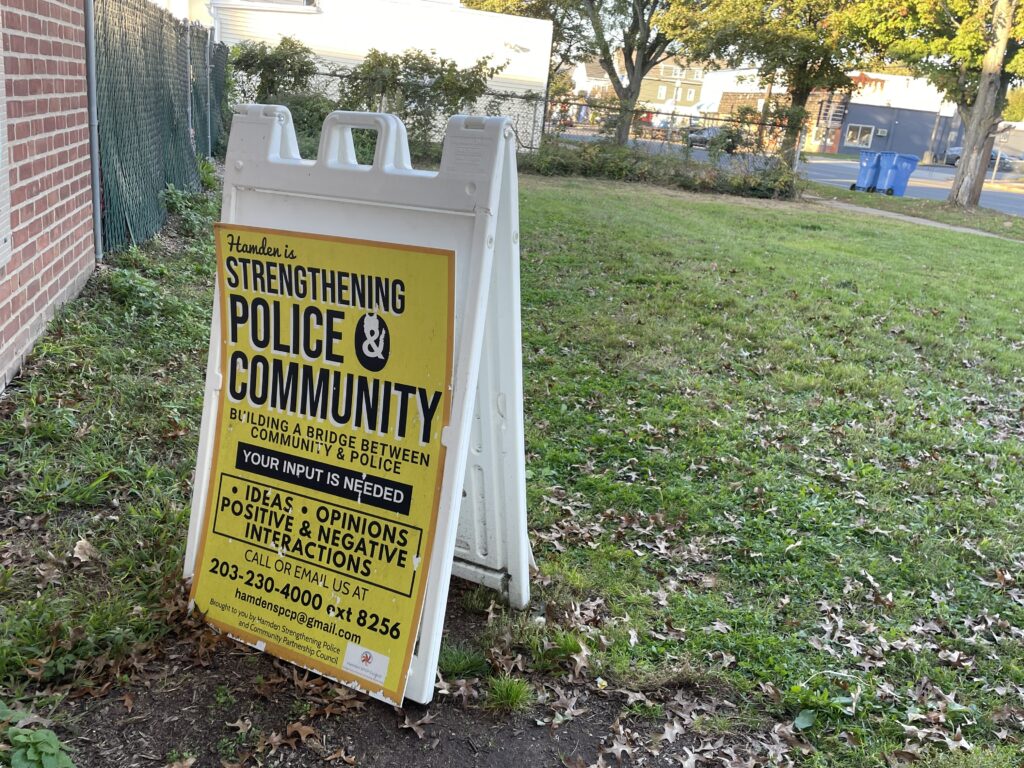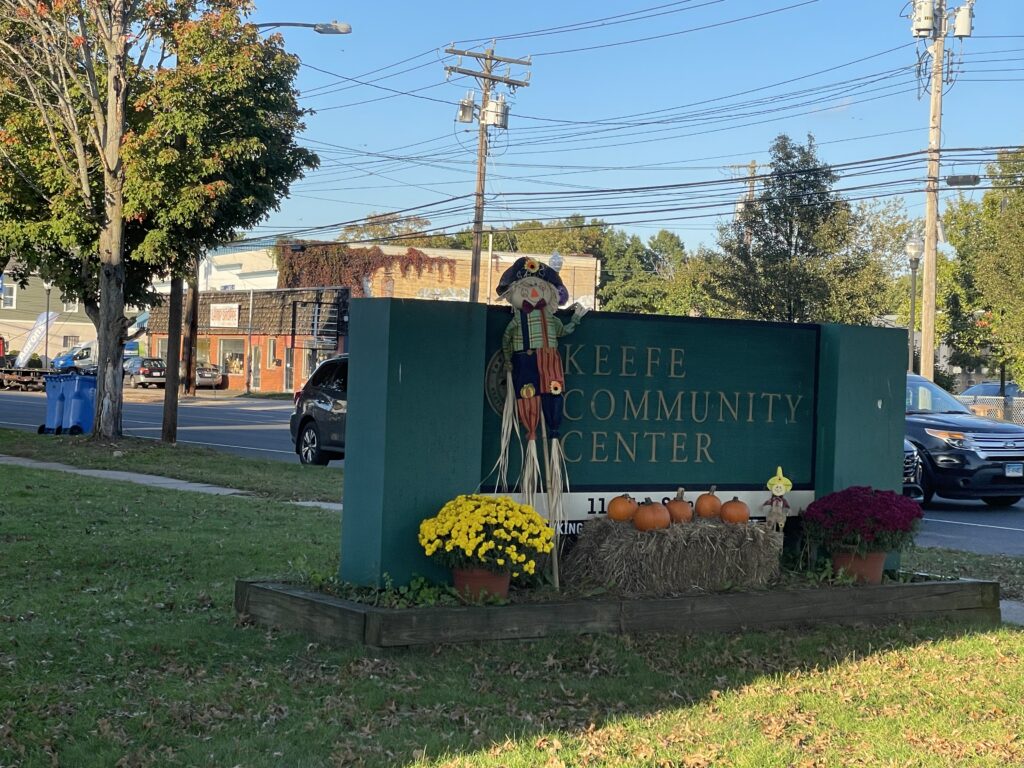He stands at the corner of the Bank of America drive-thru on Dixwell Avenue, shifting his weight from foot to foot. From out of his backpack he sheepishly removes a small, plastic water bottle and a coarse, rugged cardboard sign. The sign has seen better days, there is no doubt, with its ripped edges and bent corners. It is faded in some spots, yet darkened in others. Weathered — yes — but nonetheless his most sacred, splotchy possession. Vertically descending scribble in the shape of black bubble letters reads, “PLEASE HELP IN THE NAME OF GOD.”
His handshake is stiff. His eyes are bloodshot. Callous hands clutch the cardboard tightly, accentuating his cracked skin. A droopy beige overcoat covers most of the red sweater he wears underneath. On his head sits a black winter cap, barely pulled down past his forehead. Around his neck dangles a rusted, silver cross. Dense cargo pants whip in the wind, like a ship’s flag in the midst of a storm. His once-black sneakers are now mostly brown, on account of the mud that coats them.
Rob is homeless. The 51-year-old Waterbury, Connecticut native has been for years. His tumultuous story is one of many among the homeless that fill the streets of Hamden.

Homelessness presents itself statewide — an issue that has skyrocketed since the COVID-19 outbreak, and one that still continues to rise in 2023.
Since last year, rates of homelessness have increased by 13%, notes a report by CTNewsJunkie.com using data provided by the Connecticut Coalition to End Homelessness. Dating back to the beginning of the pandemic, rates are up 39% since 2020.
In Hamden, it’s hard to pinpoint exactly how many homeless people stay within the town lines.
Some settle down for multiple nights while others just make their way through. The number is fluid, and chances are, it probably doesn’t officially exist. On a larger, state-wide scale, the estimation sits at just over 3,000 individuals without homes.
Rob has previously leased homes in Hamden, but the lack of a steady income forced him to give them up. He’s not sure exactly how many years he’s been on the streets, but the road he’s traveled drags on long enough that he knows a thing or two about making a living for himself.
He has just one lung. He outlasted a coma spanning three weeks. During his time in the medical field, he worked as a nurse’s aid in operating rooms. He has an array of college credits, backed by a high school diploma, from both Naugatuck Valley Community College and Gateway Community College.
He likes his coffee with three creams and 12 sugars.
Affordable housing, despite the best efforts of the local government, is yet another issue that afflicts Hamden. The lack of affordable housing hinders Rob’s ability to get off the streets and into a safe place, but Rob probably wouldn’t have been able to afford that, anyway.
While he knows he can always get a job, Rob panhandles to make ends meet.
Rob is currently pursuing Supplemental Security Income, or SSI, so that he can generate enough money to get off the streets. In order to qualify for disability payments in the state of Connecticut, an individual cannot make more than $906 per month. On average, the state distributes about $1,416 per individual each month in disability payments, a slight decrease from what a $15 minimum wage payout would look like extrapolated over the course of four weeks.
Gov. Ned Lamont announced that, starting Jan. 1, 2024, the minimum wage in the state will increase yet again, from $15 an hour to $15.69.
The hope for Rob is that his particular, peculiar case would warrant more money in a check with his name on it.
Connecticut is able to pay up to $3,627 per monthly payment, depending on an individual’s situation, hence why Rob is willing to test his luck with SSI.
So, every day for about two hours, Rob stands at his spot on the bustling corner at Dixwell Avenue and Skiff Street at the Bank of America, where cars pour into the line of sight of his cardboard sign, in the hopes that he can scrape enough money together to eat for the day.
Rob’s area is a hotspot for panhandlers in Hamden. Not the corner, specifically, but Dixwell Avenue as a whole, which stands to be the epicenter of the town’s high-foot traffic, high-density shopping centers, the home of a lump sum of many popular stores.
ShopRite, Marshalls and TJ Maxx comprise the Hamden Plaza in addition to popular fast-food chains like McDonald’s, Taco Bell, Panera Bread and Starbucks.
Stores like Stop & Shop, Wendy’s and Chipotle line Dixwell Avenue and, farther south, are Hamden Mart and the Walmart, with expansive parking lots between the brick-and-mortar stores and the major throughway.
Every day, hundreds of patrons filter in and out of the four-lane road, going about their errands. Of the hundreds, it takes the compassion of just one to feed a man for a day.
The area attracts homeless people like Rob, who rely on the kindness of other people’s hearts to make a living wage.
But it also attracts attention, most of it negative, to Rob and his peers.
Like most panhandlers in the Hamden Plaza, Rob is respectful. His calm nature rivals that of another group of homeless people in town, those who use fear tactics to scare residents into paying them off.
Angela Vey, the public information sergeant of the Hamden Police Department, details occasions of people becoming aggressive with plaza shoppers, knocking on car windows and going to extreme lengths in an attempt to get customers to fork over cash — a method Rob feverently does not condone.
“We had one gentleman, who actually sadly passed away, but he was going up to people’s cars and getting on (top of) their cars,” Vey said. “We do get (complaints), but we more so get calls when they’re being aggressive.”
From what Vey could remember during her time as an active officer on the road, the department mainly receives complaints from Hamden residents concerning people who are homeless, but not as much from the business owners who operate the stores where Rob and others congregate.
“It was the people that were in vehicles that were calling,” Vey said. “Sometimes (the homeless) were being aggressive, but sometimes they just didn’t like that (the homeless) were there.”
It is only when those panhandling step onto store property when the store owners can choose to file a complaint.
“Take the (Hamden) Mart where Walmart is (for example), that’s private property,” Vey said. “We need the business owners to say that we don’t want (the homeless) there. We need to have the owner of the property say that they don’t want them there.”
Harsh? Yes, but only when panhandlers are caught accosting patrons. Those asking for money are still people, who possess the same basic human rights as everybody else. This includes the right to panhandle, as much as some people around town may not like to see it.
Regardless, the act of asking for help, whether it be for money or any other type of support, is not illegal.
Jacqueline Beirne, chairwoman of Hamden’s Strengthening Police and Community Partnerships (SPCP) committee, puts it best.
“Panhandling is not a crime in Hamden. It’s a nuisance, but not a crime.”
Jacqueline Beirne, chairwoman, SPCP
Beirne’s organization strives to “improve public safety by strengthening trust and developing partnerships between law enforcement professionals and the diverse communities they serve,” according to the committee’s website.

And yet, situations arise from time to time when panhandlers do become violent, but they’re very few and far between.
Mayor Lauren Garrett can only recall this happening once during her time in office; the issue at hand regarded a complaint made by the ALDI grocery store on Dixwell Avenue.
“In general, I don’t really receive many complaints from business owners about homelessness or panhandling,” Garrett said.
Stereotypes suggest that all panhandlers have the tendency to become violent — a stereotype brewed in falsehoods as a result of the unrelated crimes that take place in the town’s shopping centers.
This stigma, when paired with the small percentage of those who actually do have aggressive tendencies, permeates throughout the entire homeless community.
“The problem is not the homeless… it’s the people who are coming up here and stealing,” Rob said. “They stop the buses from coming in (the plaza) … they get off the bus, they steal, and they get back on the bus and go to New Haven.”
Thieves and purse-snatchers plague the plazas and their surrounding areas.
As a result, public transport has had to alter its routes to make it more difficult for criminals to make their getaways. When theft does occur, it is left to Rob and the others to pick up the pieces.
“That has nothing to do with us,” Rob says. “We’re umbrella’d all under one group.”
Not all panhandlers are homeless. And not all homeless people solicit spare change.
But Rob knows that both the conflation in people’s minds and the stereotype paint him and his peers in a negative light, casting a blanket statement over a group of people who already battle enough hardship.
Hamden’s Strengthening Police and Community Partnerships committee knows it, too.
“I personally see panhandlers. There’s one panhandler that always wants me to give him a hug,” Beirne said. “He just wants people to say hi to him, and so I say hi.”
On days that Rob is most fortunate, he isn’t in the plazas at all. Rather he is hired locally to cut grass, rake leaves or pick up trash in the area.
“I have been lucky to get little helper jobs at people’s houses,” Rob said. “They might hire me to help, so I can have a couple of hours to earn some money and actually feel like something.”
When he’s done, he’ll use however much money he’s accrued to buy lunch or dinner. After that, he’ll travel to wherever he has plans to lay his head that night.
Some people, like Rob, bounce from couch to couch in search of their next night’s sleep. Some set up tents or small camps in tucked-away areas in an attempt to declare some individualized territory to keep for themselves. Others use shopping carts to stow their few belongings, wandering the streets in search of somewhere safe to lay their heads for the night — usually in the form of homeless shelters.
Rob has watched as his fellow homeless peers drop from frostbite while waiting in line to enter local warming centers during the coldest of months.
With winter approaching, as the leaves begin to fall and the temperature takes a dive, Hamden will do what it does every year to aid the homeless during the cold season.
“Every year we open up a warming center (which has) been at (the) Keefe Community Center,” the mayor said. “It’s been a very successful center. We talk to a lot of clients that we serve there, and they come there because they feel safe.”
Hamden itself does not have any homeless shelters, with the two closest shelters open year-round located in New Haven. But in the coming months, the Hamden Police Department will work in conjunction with Garrett to open warming centers that run during the day and through the night, lending a helping hand and a chance to escape the frigid temperatures when the sun goes down.
The Keefe Community Center is one of those warming centers. It is about two and a half miles south of Hamden Plaza, and will open from 7 p.m. to 7 a.m. starting after the new year, likely around the first week of January. Alongside it, additional warming centers will open seasonally around town, a full list of which can be found here.
While those in need of temporary refuge can seek it out at these locations, warming centers are not homeless shelters. They do not offer beds simply because there is not enough room in the buildings. More importantly, the staff want to discourage the homeless from overstaying their welcome after the centers close.
Guests can assemble their own beds, but they must bring their own blankets to do so, creating make-shift pallets that line the center floors.
“Once you start providing beds, it becomes a shelter,” said Y’Isiah Lopes, a representative from the Keefe Community Center. “Then you have hospitals calling, or having hospital patients (who are homeless) getting dropped off. Because sometimes, they seek refuge at hospitals in the winter.”
In the first few days after opening to the public, the center may see 20-25 guests per night. After word gets around, it may jump up to 30. In the waning days of winter, 40 people will consistently look toward to the building on Pine Street for a safe haven.
Over the years, the center has had overwhelming success protecting its guests from the cold. Structure is most vital – ensuring that all staff members cooperate to follow the same rules, policies and procedures when dealing with a multitude of guests.
Many of the guests behave. A few watch with ill intent to see which staff members they can try to manipulate to secure a couple more snacks, drinks or donated items like blankets and clothes.
“(The) staff always know (that) if there is an immediate danger or a situation that they feel unsafe, or (if) the safety of the other guest may be in question, always call 911,” Lopes said. “From my experience, there may be five people or so (that) you have to ask (them to) leave for some sort of issue or incident.”
Lopes also reports incidents of guests trying to smoke marijuana in the bathroom on occasion. At worst, the staff asks the guests to leave. The centers only issue bans on the most extreme occasions, and they almost always allow guests to return the next night.
“Sometimes they just need a break to get away from whatever the situation was (that) they were removed for,” Lopes said. “We don’t punish them (or) permanently ban them from the warming center.”

Garrett also points to the Hamden food pantry, located next door to the Keefe Community Center, and an abundance of food trucks with fresh fruits and vegetables, to ensure that the homeless population can access clean and safe food and water.
Those who want help will have access to it. Those who don’t, which Vey says is the case with some homeless people, will endure the bitter cold on their own. Regardless, they will have ample resources provided to them to make their lives just a bit easier.
“There’s only so much that we can do … we’re happy to give them rides to the shelter,” Vey said. “But I have to tell you, a lot of the time, people don’t want the help.”
Nobody’s desired destination is homelessness. Nobody wakes up one day and chooses to ditch the roof over their head – Rob knows that intimately.
Rather, the state of homelessness is the culmination of hundreds of potential factors, both big and small. The two biggest issues, to both of which Rob attributes some part of his fall from grace, are mental health struggles and the abuse of drugs and or alcohol.
Beirne of the SPCP details the hardships of battling mental illnesses on the streets.
“From a humanitarian point of view … a lot of those individuals have mental illnesses that have gone untreated,” Beirne said. “They are victims more so than they are perpetrators.”
The stigma around the homeless is that they are violent, drug-addicted criminals whose choices have landed themselves at rock bottom. In reality, they’re ordinary people, typically down-on-their-luck individuals just trying to get a second chance at life.
For Rob, he panhandles not because he prefers to, but because he has to.
“After I got out of my coma, I got denied for disability two times, so that’s a lot of my problem, is that I can’t get disability,” he said, wiping his forehead and scrunching his face.
Serving as a barrier between him and a better life, this obstacle has strong-armed Rob long enough. If he was to get even a minimum wage job, his earnings would total higher than the threshold necessary to qualify for SSI, which is why he must panhandle until he is granted disability payments.
“Everybody says you have to be denied three, four times until you get it, but in the meantime I have no income,” he said.
Years ago, the police arrested Rob on charges of possessing marijuana with the intent to sell.
As a result of his arrest, he lost his job, effectively shutting the door on his career in the medical field. At some point down the line, he said he developed pneumonia — the cause of his aforementioned coma — before waking up with one less lung, no home, no income and a despairing outlook on life.
“A lot of what comes with homelessness is definitely drug abuse and depression,” Rob said. “Knowing you don’t have a stable place to stay is always messing with your head.”
Each day is a new challenge – a new test with the answers unknown – but for Rob and so many others, whose lives have been long burdened by the powerlessness of living without their name on a lease, each day is one to be thankful for.
“I’m grateful for waking up. I’m grateful for the blessings that I get.”
Rob, 51


One reply on “Mental health, Hamden Plaza and living without your name on a lease: The misconstrued stigma surrounding homelessness in Hamden”
I lived in a homeless shelter. It’s dangerous and people look down on you (some). Good luck everyone….